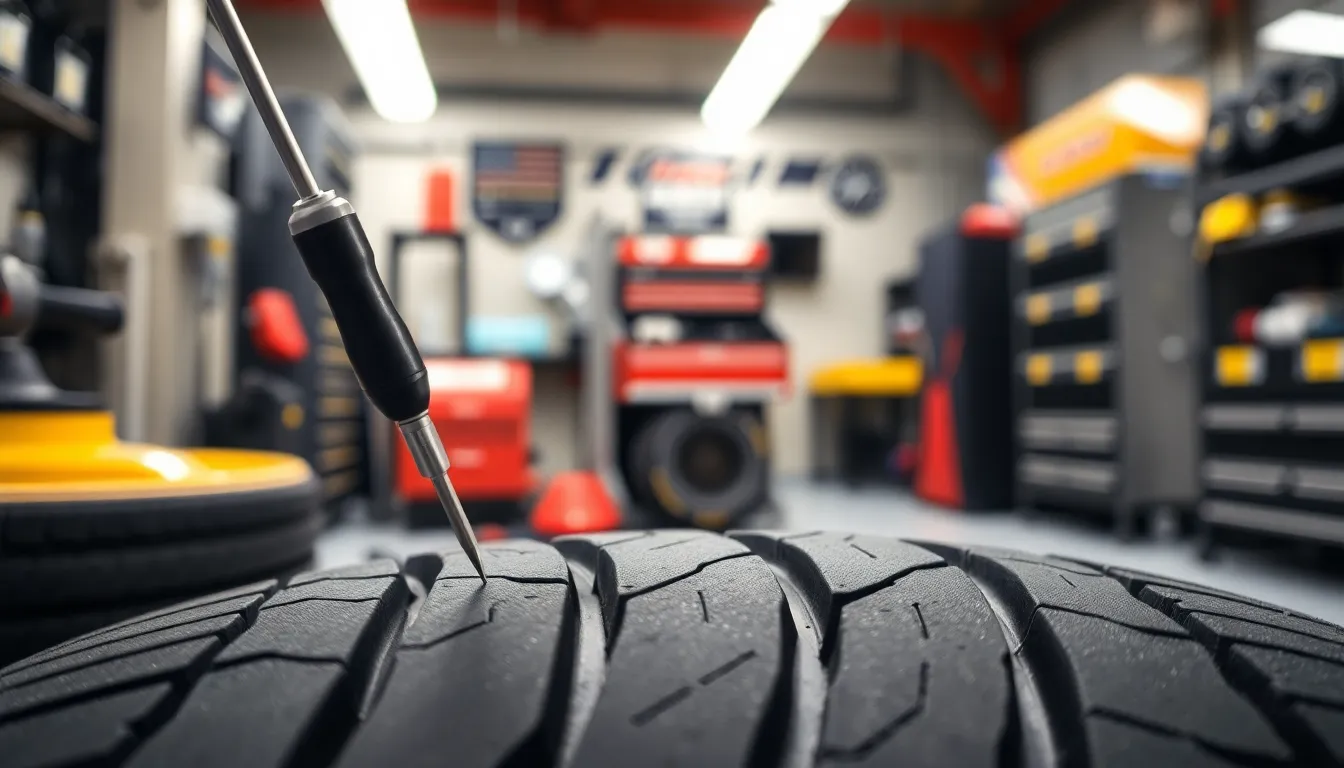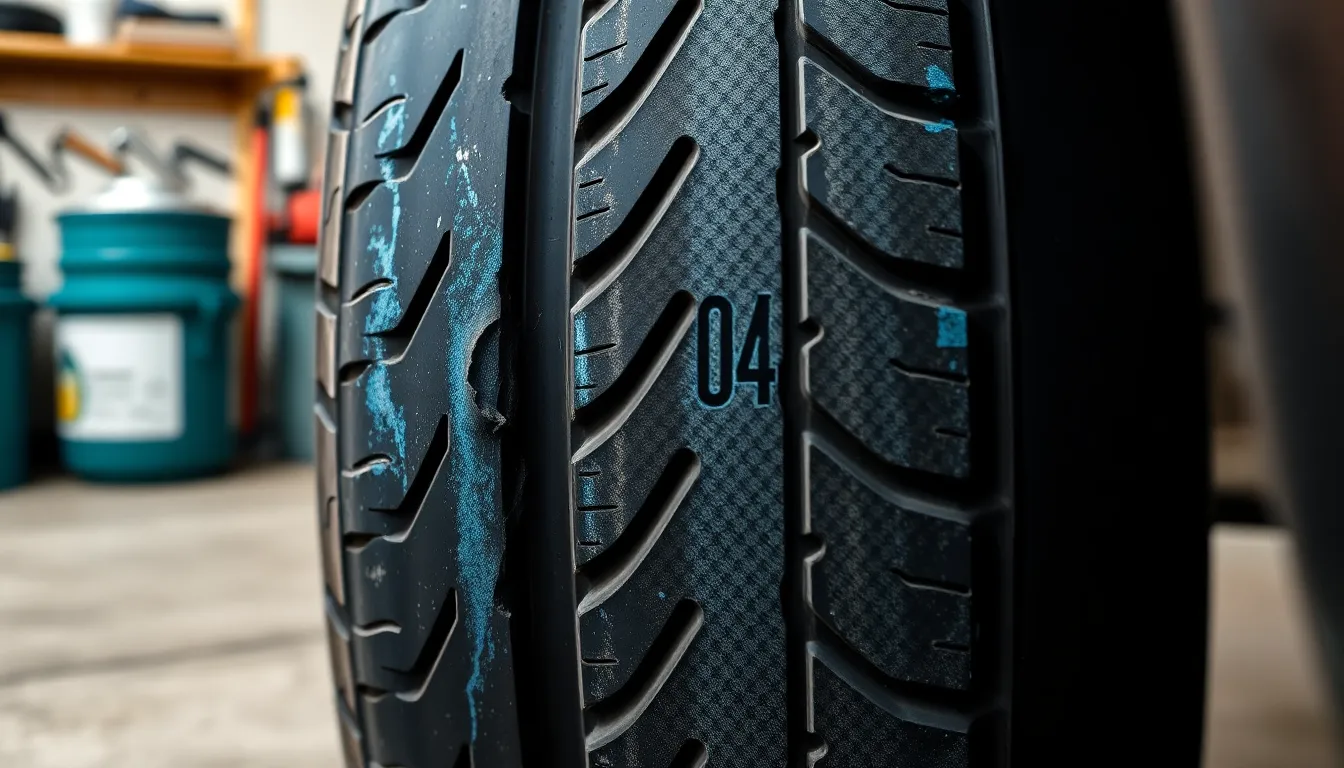We’ve all felt that surge of confidence when our tires grip the road perfectly during a spirited drive. But what many drivers don’t realize is that tire temperature plays a crucial role in this performance equation. Whether you’re pushing your car to its limits on a track day or simply handling daily commutes tire temperature directly affects everything from grip levels to tire longevity.
Understanding how heat impacts your tires isn’t just for racing enthusiasts – it’s essential knowledge for every driver who wants maximum performance and safety. From the science behind optimal operating temperatures to practical monitoring techniques we’ll explore how temperature management can transform your driving experience.
The difference between properly warmed tires and cold rubber can mean the distinction between confident cornering and unexpected slides. Let’s jump into the intriguing area of tire temperature and discover how this often-overlooked factor can elevate your driving game.
What Is Tire Temperature and Why It Matters
Tire temperature represents the heat generated within the rubber compound and internal structure during vehicle operation. Operating temperatures typically range from 80°F to 200°F depending on driving conditions and tire specifications.
Heat generation occurs through three primary mechanisms that affect tire performance. Flexing creates internal friction as the tire deforms during rotation. Rolling resistance produces thermal energy from contact patch compression against road surfaces. Braking and acceleration generate additional heat through increased grip demands.
We measure tire performance across exact temperature ranges that determine optimal functionality:
| Temperature Range | Performance Impact | Typical Conditions |
|---|---|---|
| 80°F – 120°F | Reduced grip, longer stopping distances | Cold weather, initial startup |
| 120°F – 160°F | Optimal performance zone | Normal driving conditions |
| 160°F – 200°F | Peak grip for performance tires | Aggressive driving, track use |
| Above 200°F | Degraded performance, potential damage | Extreme conditions, overheating |
Temperature directly influences the rubber compound’s molecular structure and grip characteristics. Cold tires exhibit reduced flexibility and decreased contact patch effectiveness. Properly warmed tires provide maximum traction through improved rubber pliability and enhanced road surface conformity.
Excessive heat causes tire degradation through accelerated wear patterns and potential structural damage. Overheated tires experience reduced grip levels even though increased temperatures. Compound breakdown occurs when internal temperatures exceed manufacturer specifications.
Performance driving demands precise temperature management for consistent lap times and vehicle control. Racing applications use tire warmers to achieve optimal operating temperatures before track sessions. Street driving benefits from understanding temperature effects during seasonal transitions and emergency situations.
Safety implications extend beyond performance considerations to include blowout prevention and handling predictability. Monitoring tire temperatures helps identify alignment issues, pressure problems, and suspension concerns before they create dangerous situations.
How Tire Temperature Affects Performance

Tire temperature directly influences multiple aspects of vehicle performance, creating measurable changes in how our vehicles handle, stop, and grip the road. Understanding these temperature effects helps us optimize our driving experience and maintain vehicle safety across different conditions.
Traction and Grip Changes
Higher tire temperatures enhance traction by allowing rubber compounds to better conform to road surfaces, improving overall grip until reaching optimal temperature ranges. Cold rubber becomes less pliable and reduces our ability to maintain consistent contact with the pavement, resulting in decreased grip levels during initial driving phases.
Excessive heat beyond optimal temperatures leads to reduced grip performance due to rubber overheating and compound degradation. We observe maximum traction when tires operate within their designed temperature windows, typically between 160°F to 200°F for performance applications.
Handling and Steering Response
Elevated tire temperatures combined with higher speeds create degradation in vehicle handling characteristics and steering responsiveness. Hot tires experience reduced structural integrity, making our steering inputs less precise and predictable during ever-changing driving situations.
Temperature increases affect tire sidewall stiffness, which directly impacts how quickly our vehicle responds to steering corrections. We notice decreased handling precision when tire temperatures exceed manufacturer specifications, particularly during extended high performance driving sessions.
Braking Distance Variations
Tire temperature changes affect braking performance by altering contact patch characteristics and available friction between tire and road surface. Higher temperatures increase tire pressure, which modifies the tire’s contact area and can extend our stopping distances beyond normal parameters.
Temperature fluctuations impact tire stiffness, with overheated tires potentially increasing braking distances due to reduced traction capabilities. We must account for these temperature related braking variations, especially during track events or extended mountain driving where sustained heat buildup occurs.
Optimal Temperature Ranges for Different Tire Types

Different tire categories perform optimally within exact temperature windows. Understanding these ranges helps drivers maximize both safety and performance across varying seasonal conditions.
Summer Tires
Summer tires achieve peak performance when tested at ambient temperatures around 59°F (15°C). These tires operate safely up to approximately 158°F (70°C) during driving conditions, though optimal grip occurs when the tire warms above ambient temperature without overheating.
Cold temperatures below recommended ranges create stiffness and significantly reduce grip levels. Excessive heat accelerates wear patterns and causes traction loss, making temperature management critical for summer tire longevity.
| Temperature Factor | Summer Tire Specification |
|---|---|
| Ambient Testing | 59°F (15°C) |
| Safe Operating Range | Up to 158°F (70°C) |
| Optimal Performance | Warmed above ambient |
Winter Tires
Winter tires demonstrate reliable performance when tested at ambient temperatures around 23°F (-5°C). Engineers design these tires with specialized compounds that maintain flexibility in freezing conditions while their internal temperature may rise during operation.
Warm temperatures cause winter tires to become overly soft and degrade rapidly. This degradation makes them unsuitable for hot climates and reduces their effectiveness when temperatures exceed their design parameters.
Performance optimization occurs when winter tires operate in freezing or near-freezing conditions where their compound formulation provides maximum traction benefits.
All-Season Tires
All-season tires function across a broad temperature spectrum from approximately 20°F (-7°C) to 110°F (43°C). Their performance represents a compromise between summer and winter tire capabilities, providing moderate grip in both temperature extremes.
Cold weather reduces flexibility compared to dedicated winter tires. Hot weather conditions limit grip performance relative to specialized summer tire compounds.
Temperature effects on all-season tires create predictable performance trade-offs rather than the specialized optimization found in seasonal tire designs.
Factors That Influence Tire Temperature

Several key factors directly impact tire temperature during vehicle operation. Understanding these influences helps us maintain optimal tire performance and safety across different driving scenarios.
Driving Conditions and Speed
Speed significantly affects tire temperature through increased friction between the tire and road surface. Rapid acceleration, hard braking, and aggressive cornering generate substantial heat due to internal hysteresis within the rubber compound. Rolling speeds create greater temperature increases within the tire tread, which degrades handling performance and accelerates tire wear.
Out-of-balance tires produce localized heat pulses at exact imbalance points. These heat concentrations can cause uneven wear patterns and reduced tire longevity. Maintaining proper wheel balance prevents these temperature spikes and ensures even heat distribution across the tire surface.
Ambient Weather Temperature
External environmental conditions directly influence tire operating temperatures. Road surface temperature affects tread temperature, with higher ambient conditions leading to elevated tire heat levels. Sidewall temperature responds particularly to air temperature and solar radiation exposure.
Cold climates keep tires closer to ambient temperatures, while hot weather pushes tire temperatures above safe operating thresholds. Summer road surfaces can reach temperatures exceeding 140°F, significantly impacting tire performance and safety margins.
Tire Pressure and Load
Proper tire inflation ranks as the most critical operational factor affecting tire temperature in normal highway conditions. Underinflation increases rolling resistance and heat buildup, accelerating tire wear and failure risk. Overloading vehicles or running with excessive sprung mass elevates internal tire temperatures beyond safe limits.
The priority order for temperature-affecting factors follows: inflation pressure, vehicle load, and speed. Maintaining correct tire pressure ensures optimal heat dissipation and safety performance across all driving conditions.
| Factor | Impact on Tire Temperature |
|---|---|
| Driving Conditions/Speed | Increases tread temperature, affects wear |
| Ambient Weather | Raises tread (road temp) & sidewall (air/sun) |
| Tire Pressure and Load | Underinflation/overload increase temperature |
How to Monitor and Measure Tire Temperature

Monitoring tire temperature requires exact tools and techniques that provide accurate readings for optimal vehicle performance. We can choose between two primary measurement methods depending on our exact needs and circumstances.
Contact Measurement Using Needle Probes
Needle probe thermometers offer the most precise temperature readings by penetrating directly into the tire tread. These devices insert a thin probe approximately 3 to 5 mm into the rubber compound to measure internal temperature at the exact depth where heat affects tire performance.
Benefits of needle probes include:
- Precise compound temperature readings at the critical depth
- Targeted measurement capabilities for detecting exact tire issues like blistering or graining
- High accuracy for internal temperature assessment
Limitations we encounter with needle probes:
- Delicate construction makes the thin probes vulnerable to damage
- Slower measurement speed requiring 2.5 to 3 seconds per reading
- Reduced accuracy when measuring asphalt temperature due to penetration requirements
Non-Contact Infrared Measurement
Infrared pyrometers measure tire surface temperature using thermal sensors without physical contact with the tire. These devices capture temperature readings in approximately 0.5 seconds making them ideal for quick assessments.
Advantages of infrared measurement include:
- Rapid measurement speed for efficient temperature monitoring
- Average surface temperature readings across the field of view
- Excellent accuracy for measuring road surface temperatures
- No physical contact eliminating probe damage concerns
Considerations for infrared use:
- Precise aiming requirements for consistent measurements
- Regular cleaning needed to prevent rubber debris interference
- Surface temperature only without internal compound readings
Advanced Measurement Technologies
Heat Balance Equation systems combine infrared technology with specialized thermocouples to estimate internal tire temperature approximately 6 mm deep. These advanced systems calculate heat balance rather than measuring surface temperature alone providing more comprehensive temperature data.
Key features include:
- Internal temperature estimation through heat balance calculations
- Controller integration for data acquisition systems
- Calibration protocols comparing infrared readings with insertion probe data
Measurement Method Comparison
| Method | Measurement Type | Depth | Speed | Accuracy | Notes |
|---|---|---|---|---|---|
| Needle Probe | Contact insertion | 3-5 mm compound | 2.5-3 seconds | High for local temperature | Delicate probe slower operation |
| Infrared Pyrometer | Non-contact surface | Surface only | 0.5 seconds | High for surface and asphalt | Requires proper aiming and cleaning |
Practical Application Guidelines
Professional motorsport teams often combine both measurement methods to create comprehensive temperature profiles. Contact probes provide critical internal compound data while infrared sensors enable rapid surface temperature monitoring across multiple tire locations.
Temperature monitoring informs suspension tuning alignment settings and tire compound selection decisions. Consistent measurement protocols help identify temperature variations across tire surfaces improving both longevity and track performance through data-driven setup adjustments.
Managing Tire Temperature for Better Performance

Managing tire temperature effectively bridges the gap between understanding thermal dynamics and applying practical techniques for optimal driving performance. We can control tire heat through strategic warm-up procedures and active cooling methods during extended driving sessions.
Pre-Drive Warm-Up Techniques
Ever-changing warm-up represents the most accessible method for achieving optimal tire temperature before demanding driving conditions. We accomplish this by driving gently for several minutes, allowing gradual heat buildup through natural flexing and rolling resistance. Racing applications often employ static warm-up using tire blankets or specialized heaters to ensure even heat distribution across the entire tire surface before track sessions.
Professional motorsport teams typically maintain tire blanket temperatures between 180°F and 200°F for racing slicks, creating immediate optimal grip conditions. Street drivers benefit from a 5-10 minute gentle driving period, focusing on smooth acceleration and braking to achieve consistent temperature elevation. Ambient conditions affect warm-up duration, with cold weather requiring extended preparation time compared to moderate temperatures.
Cooling Methods During Extended Use
Airflow enhancement provides the primary cooling mechanism during sustained high-performance driving sessions. We maximize heat dissipation by ensuring proper brake duct positioning and avoiding wheel covers that restrict air circulation around tire sidewalls. Racing vehicles often incorporate specialized cooling ducts that channel airflow directly onto tire surfaces during operation.
Brake cooling systems indirectly manage tire temperature by reducing heat transfer from brake components to adjacent tire areas. Modern performance vehicles use ventilated brake rotors and strategic air ducting to minimize thermal transfer between braking systems and tires. Specialized tire designs featuring advanced tread patterns and heat-resistant compounds actively manage thermal buildup through improved heat distribution and dissipation characteristics.
Extended driving sessions benefit from periodic cooling intervals, allowing tire temperatures to stabilize within optimal operating ranges. We monitor surface temperatures using infrared pyrometers to ensure temperatures remain below critical thresholds that could compromise tire integrity or performance capabilities.
Signs of Temperature-Related Tire Problems

Temperature-related tire problems manifest through several distinct visual and performance indicators that we can identify during regular inspections. Irregular wear patterns serve as the primary warning sign, particularly when excessive wear appears concentrated in the center of the tire tread due to overheating conditions.
Tread damage becomes apparent through tearing and chunking patterns that develop when tire temperatures exceed safe operating thresholds. These physical deteriorations occur most frequently during sustained high-speed driving or aggressive cornering sessions where heat buildup surpasses the tire’s thermal capacity.
Visual indicators provide immediate clues about temperature-related tire stress through exact color and surface changes. A blue tint to the rubber indicates overheating has occurred, while bulges and blisters signal internal structural damage from excessive heat exposure.
| Temperature Problem | Visual Sign | Performance Impact |
|---|---|---|
| Overheating | Blue tint to rubber | Reduced traction |
| Heat damage | Bulges and blisters | Increased failure risk |
| Thermal stress | Peeling and discoloration | Compromised grip |
| Excessive wear | Center tread deterioration | Shortened tire life |
Peeling and discoloration appear as secondary indicators when temperature damage progresses beyond initial stages. These surface changes typically accompany more severe internal degradation that compromises tire integrity and safety performance.
Performance issues emerge through noticeable reductions in traction and handling response during normal driving conditions. Overheating diminishes the tire’s ability to maintain proper contact with road surfaces, leading to decreased grip levels and unpredictable vehicle behavior.
Pressure fluctuations accompany temperature changes at a rate of approximately 1 psi for every 10-degree temperature variation. These pressure changes can exacerbate existing temperature problems and create cascading effects that accelerate tire degradation.
Ignoring these warning signs leads to irreversible damage and substantially increases the risk of catastrophic tire failure during operation. Regular visual inspections combined with pressure monitoring provide essential early detection capabilities that prevent minor temperature issues from developing into dangerous situations.
Safety Considerations and Best Practices

Temperature A tires effectively dissipate heat at speeds exceeding 115 miles per hour and withstand temperatures up to 249°F. These high-performance tires require exact safety protocols to prevent heat-related failures that could compromise vehicle control.
Heat deterioration poses important risks during sustained high-temperature exposure. Extended driving sessions generate excessive thermal buildup that weakens tire structure and increases blowout probability. Tread separation becomes more likely when operating temperatures exceed safe thresholds for prolonged periods.
Pressure monitoring demands constant attention because tire pressure increases approximately 1 PSI for every 10°F temperature rise. We recommend checking tire pressure before driving and adjusting based on ambient conditions. Hot weather driving requires more frequent pressure assessments to maintain optimal performance levels.
Temperature thresholds create critical safety boundaries that drivers must recognize. Operating temperatures above 167°F signal potential problems requiring immediate monitoring. Temperatures reaching 200°F represent emergency conditions demanding immediate tire inspection and possible replacement.
Regular maintenance practices protect against temperature-related tire failures. Monthly pressure checks using accurate gauges ensure proper inflation levels across varying weather conditions. Visual inspections reveal early warning signs like irregular wear patterns or rubber discoloration indicating overheating damage.
Tire Pressure Monitoring Systems (TPMS) provide real-time temperature alerts particularly valuable for trailer applications. These systems detect dangerous thermal conditions before catastrophic failure occurs. Professional-grade infrared pyrometers offer precise surface temperature measurements for performance driving applications.
Proper inflation maintains optimal heat dissipation by ensuring correct contact patch distribution. Underinflated tires generate excessive heat through increased sidewall flexing and rolling resistance. Overinflation concentrates heat in the center tread area and reduces overall tire footprint.
Load management prevents excessive heat generation by maintaining manufacturer-specified weight limits. Overloading increases tire stress and elevates operating temperatures beyond safe parameters. We advise checking vehicle weight distribution regularly especially when carrying cargo or passengers.
Driving technique modifications reduce heat buildup during high-performance scenarios. Gradual acceleration and smooth cornering minimize sudden temperature spikes that stress tire compounds. Extended high-speed driving requires cooling periods to prevent thermal accumulation exceeding safe operating ranges.
Conclusion
Understanding tire temperature management transforms how we approach vehicle safety and performance. We’ve explored the critical balance between generating adequate heat for optimal grip while preventing dangerous overheating scenarios that compromise tire integrity.
The key lies in consistent monitoring and proactive maintenance practices. By implementing proper warm-up techniques measuring temperatures regularly and recognizing early warning signs we can extend tire life and enhance driving confidence across all conditions.
Whether we’re daily commuters or performance enthusiasts mastering tire temperature control gives us the tools to maximize safety and extract the best performance from our vehicles. Smart temperature management isn’t just about better grip—it’s about preventing costly failures and ensuring predictable handling when we need it most.
Frequently Asked Questions
What is the ideal tire temperature for optimal performance?
The ideal tire temperature varies by tire type. Summer tires perform best around 59°F ambient temperature with safe operating temperatures up to 158°F. Winter tires are optimal at 23°F, while all-season tires work effectively from 20°F to 110°F. Professional racing teams often maintain tire blanket temperatures between 180°F and 200°F for maximum grip.
How does tire temperature affect vehicle safety?
Tire temperature directly impacts safety by affecting grip levels and handling predictability. Cold tires reduce traction, while properly warmed tires provide maximum grip. Excessive heat can lead to tire degradation, blowouts, and tread separation. Temperature monitoring helps prevent these dangerous situations and identifies potential alignment or pressure issues early.
What causes tires to heat up during driving?
Tire heating occurs through three main mechanisms: flexing of the rubber compound, rolling resistance as the tire contacts the road, and friction from braking and acceleration. Aggressive driving, rapid acceleration, hard cornering, and sustained high speeds generate the most heat. Underinflated tires and excessive loads also significantly increase temperature buildup.
How can I tell if my tires are overheating?
Signs of overheating include irregular wear patterns (especially center tread wear), tread damage like tearing or chunking, visual indicators such as blue-tinted rubber, bulges, or blisters, reduced traction and handling response, and pressure fluctuations. Regular visual inspections and pressure monitoring help detect these warning signs before they become dangerous.
What tools can measure tire temperature accurately?
Two primary methods exist for measuring tire temperature: contact measurement using needle probes for internal readings, and non-contact infrared pyrometers for surface temperatures. Advanced Heat Balance Equation systems combine both technologies. Professional teams often use both methods to create comprehensive temperature profiles for optimal performance tuning.
How long should I warm up my tires before driving?
For street driving, a 5-10 minute gentle warm-up period is recommended to gradually build tire heat. Avoid aggressive acceleration or cornering during this time. Racing teams use tire blankets to pre-heat tires to optimal temperatures before track sessions. The key is gradual heat buildup rather than sudden temperature spikes.
Can tire temperature affect braking performance?
Yes, tire temperature significantly impacts braking performance by altering contact patch characteristics and grip levels. Cold tires provide less braking grip, while properly warmed tires offer maximum stopping power. However, excessive heat can extend stopping distances and reduce braking effectiveness, particularly during sustained high-performance driving scenarios.
What’s the maximum safe operating temperature for tires?
High-performance tires can typically withstand temperatures up to 249°F, but this requires strict safety protocols. Summer tires should stay below 158°F, while operating temperatures above 200°F generally indicate dangerous conditions. Regular monitoring with infrared pyrometers helps ensure temperatures remain within safe operating ranges during extended driving sessions.
How does ambient weather affect tire temperature?
Hot weather conditions, including high road surface temperatures and solar radiation, can push tire temperatures above safe thresholds even during normal driving. Cold weather stiffens tire compounds, reducing grip until proper operating temperature is reached. Ambient conditions directly influence how quickly tires reach optimal temperature and their maximum safe operating limits.
What are the best practices for managing tire temperature?
Best practices include regular pressure monitoring (monthly checks recommended), proper inflation and load management, gradual warm-up periods, monitoring with TPMS systems, visual inspections for overheating signs, and driving techniques that minimize sudden temperature spikes. For extended sessions, ensure adequate airflow and consider brake cooling systems to manage overall thermal buildup.

